The understated elegance of sage green has made it one of the most sought-after colors in modern kitchen design. Its soothing tone strikes a perfect balance between warmth and freshness, making it an ideal choice for creating a welcoming yet stylish space. As homeowners increasingly seek designs that evoke a sense of calm and harmony, sage green kitchens offer a timeless appeal that blends seamlessly with various styles, from farmhouse to contemporary. Whether you’re renovating or refreshing your space, this versatile shade provides countless opportunities to craft a kitchen that feels personal, inviting, and truly on-trend. Keep reading for ideas that inspire transformation.
Two-Toned Sage Green and White Cabinets
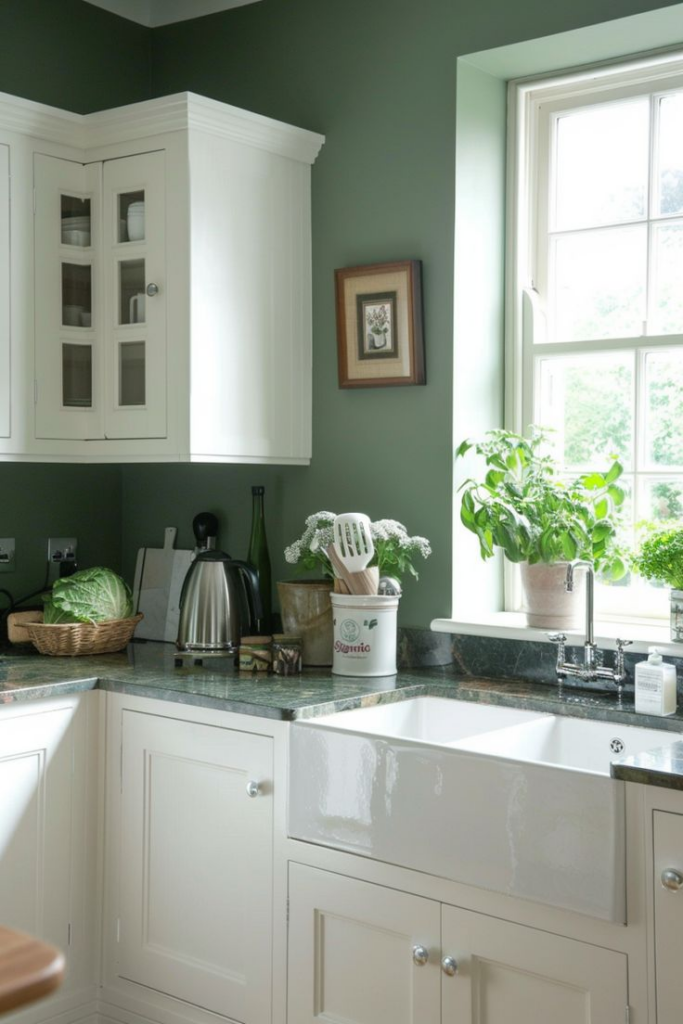
Visual harmony can transform a kitchen, and a two-toned palette of sage green and white cabinets provides a striking balance between calm and bright tones. Sage green, known for its soothing qualities, pairs beautifully with the crisp elegance of white, creating a timeless and refreshing aesthetic. Opting for sage green on the lower cabinets grounds the space, while white upper cabinets reflect light and make the room feel more open. This combination works exceptionally well in kitchens with limited natural light, as the white cabinetry amplifies brightness while the sage green adds depth and sophistication.
To add subtle contrast, consider shaker-style doors for the sage green cabinets, while the white cabinetry can feature a simpler flat-panel design. This approach adds a layer of texture without overwhelming the overall look. Pairing this design with matte black or antique brass hardware enhances the aesthetic with a modern or vintage touch, depending on your kitchen’s vibe.
The countertops play a significant role in tying the look together. For a cohesive appearance, consider marble or quartz with subtle veining that echoes the green and white tones. Backsplash choices, such as subway tiles in white or sage, can further elevate the design by seamlessly blending into the palette. Alternatively, hand-painted tiles with green and white patterns can bring an artisanal charm to the space.
Wooden flooring or wood-look tiles complement this cabinetry duo beautifully, introducing a natural warmth that softens the overall color scheme. Accessories, such as greenery or ceramic pieces, further enhance the organic feel of the space. LED under-cabinet lighting highlights the two-tone effect, adding depth and functionality to the kitchen.
This combination not only brings a fresh, stylish aesthetic to your kitchen but also ensures longevity in design, as both sage green and white are versatile enough to adapt to changing trends. Perfect for both modern and farmhouse-inspired spaces, this look is a fail-proof choice for homeowners seeking timeless elegance with a hint of personality.
Sage Green Island with Marble Waterfall Countertop
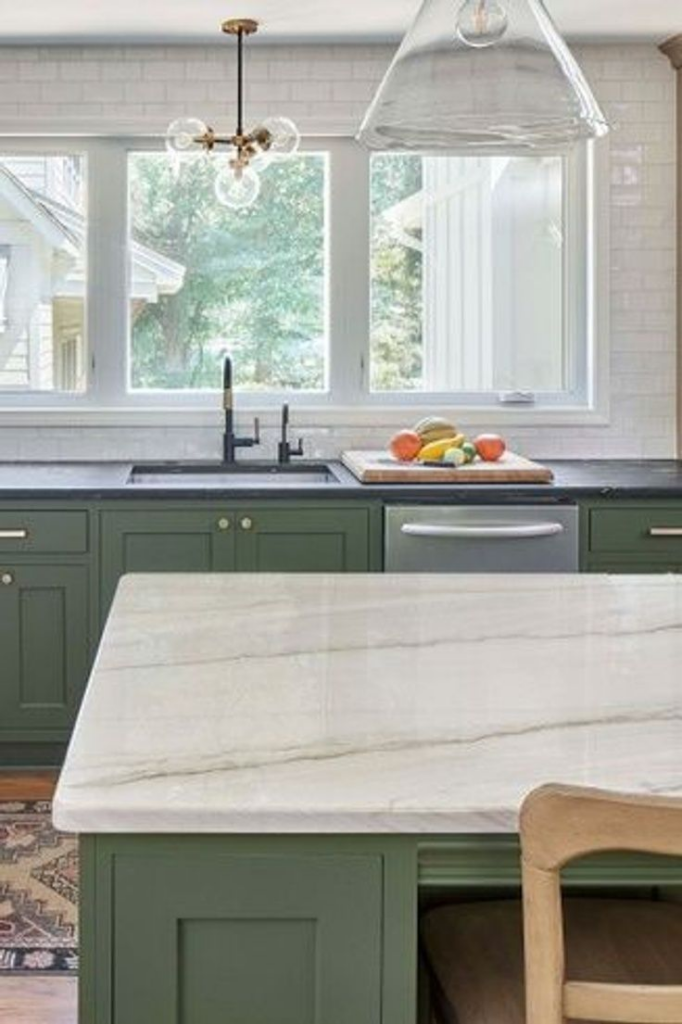
Centralizing the kitchen with a sage green island crowned by a marble waterfall countertop introduces a luxurious focal point. The waterfall design, where the marble seamlessly flows over the sides, offers an ultra-modern, clean-lined aesthetic that pairs beautifully with the earthy warmth of sage green. This combination balances bold sophistication and natural charm, making it ideal for kitchens aiming to feel both elegant and welcoming.
Selecting marble with subtle gray veining allows the sage green base to stand out while maintaining cohesion. The smooth, polished texture of the countertop contrasts gently with the matte finish of sage green cabinetry, creating a tactile experience that feels high-end yet approachable. Incorporate built-in storage within the island, utilizing shaker-style cabinets or drawers for functionality without sacrificing style.
For seating, opt for bar stools with wooden or upholstered finishes to add a layer of comfort and practicality. Brass or black pendant lights above the island will draw the eye upward, offering both illumination and visual balance. To further complement the design, consider a backsplash that subtly echoes the marble’s veining, tying the space together with a sense of flow.
The island can double as a workspace, dining spot, or even a baking station, making it a hub of activity. Incorporating a sink or stovetop into the island elevates its functionality further, perfect for hosting and meal prep alike. The sage green tone harmonizes with surrounding elements, creating an inviting and serene kitchen ambiance.
By combining the warmth of sage green with the timeless appeal of marble, this concept brings a touch of grandeur to any kitchen, ensuring it remains both practical and visually stunning. Ideal for larger kitchens or open-concept designs, this pairing sets the stage for a space that feels luxurious yet deeply grounded in natural beauty.
Matte Sage Green Cabinets with Brass Hardware
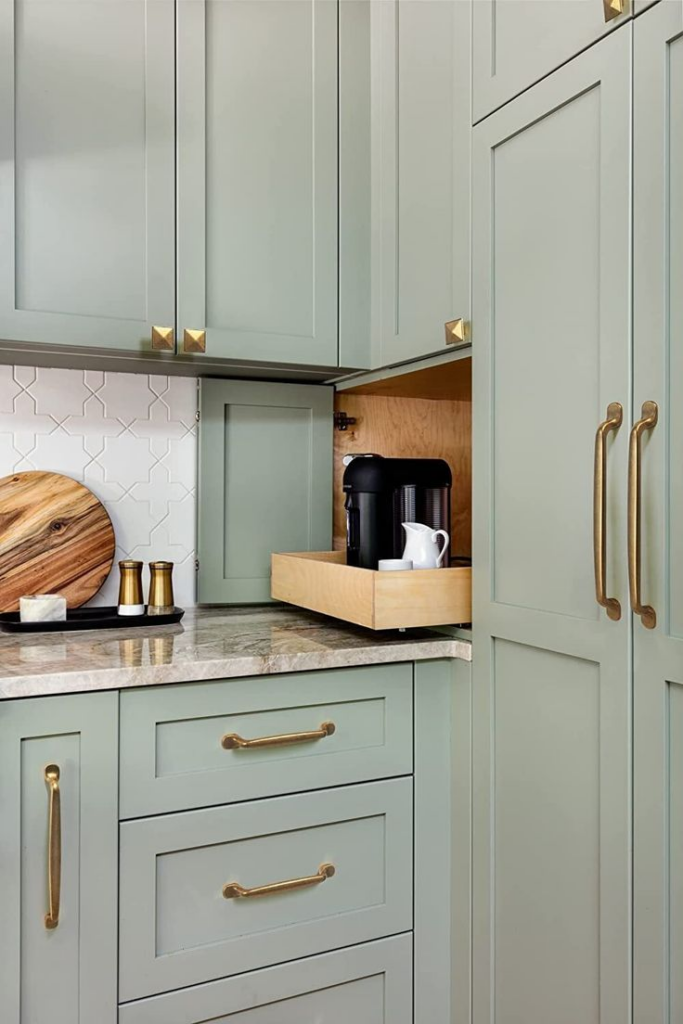
Muted green tones and brass hardware create a stunning interplay of color and texture. The matte finish softens the sage green’s impact, giving the cabinets a modern yet understated charm. Brass handles or knobs introduce a touch of vintage glamour, bridging the gap between contemporary and traditional styles.
Matte sage green cabinetry works well in both large and small kitchens. The non-reflective surface helps maintain a warm and grounded atmosphere, while the metallic brass accents catch the light, offering contrast and dimension. To further elevate the design, consider glass-front upper cabinets or open shelving to balance the matte finish with elements of transparency.
Pairing these cabinets with light-colored countertops, such as cream or soft white quartz, ensures a cohesive, airy look. Flooring options in light oak or herringbone patterns add a natural element that complements the green cabinetry. You can enhance the overall design by choosing a backsplash in textured tiles or neutral tones, which amplify the visual depth without overshadowing the cabinetry.
Lighting is crucial in highlighting the matte finish and brass accents. Install warm LED strips under the cabinets to enhance the hardware’s sheen. Decorative pendant lights in brushed brass or with frosted glass shades can add a cohesive yet elegant touch to the space.
Accessorize with functional yet beautiful elements like brass-trimmed containers or vintage-inspired brass faucets to unify the look. The cabinetry’s muted tone ensures the kitchen remains soothing and timeless, while the brass hardware injects a sense of luxury, making this combination ideal for homeowners seeking balance between practicality and style.
Sage Green Backsplash with Hand-Painted Tiles
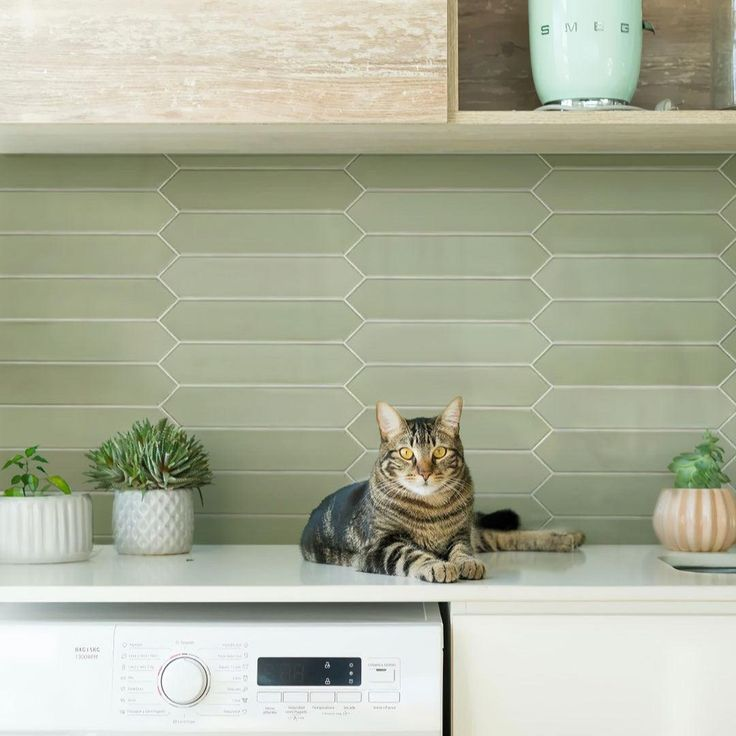
A backsplash featuring hand-painted tiles in sage green introduces artistry and character to the kitchen. These tiles combine functionality with a bespoke aesthetic, elevating the space with their intricate designs. Each tile’s unique craftsmanship makes the backsplash not just a practical feature but a work of art that transforms the kitchen into a statement space.
Opt for patterns that incorporate soft whites or earthy tones to complement the sage green without overwhelming the design. Moroccan-inspired or botanical motifs work particularly well, adding depth and texture to the walls. For kitchens with sage green cabinetry, this backsplash can create a seamless flow, enhancing the visual harmony. Alternatively, pair it with neutral cabinets for a subtle contrast that highlights the backsplash as the centerpiece.
When installing hand-painted tiles, ensure they are sealed properly to protect against stains and splashes. Their slightly imperfect, artisanal texture lends a warm, handmade feel to the space. Consider framing the backsplash area, such as behind the stove, with a border tile to define the space further and add a touch of refinement.
Countertops in light marble or quartz with minimal veining work best to let the backsplash take center stage. To tie the elements together, introduce accents like sage green cookware, ceramic vases, or wooden utensils displayed on open shelves. Lighting, such as under-cabinet LEDs, enhances the backsplash’s details, bringing out its intricate patterns and sage tones.
This style works beautifully in rustic, boho, and Mediterranean-inspired kitchens, offering a timeless appeal. Beyond its aesthetic value, the hand-painted backsplash ensures a kitchen design that feels deeply personal and unique, making it a memorable and inspiring space.
Wooden Open Shelves Against Sage Green Walls
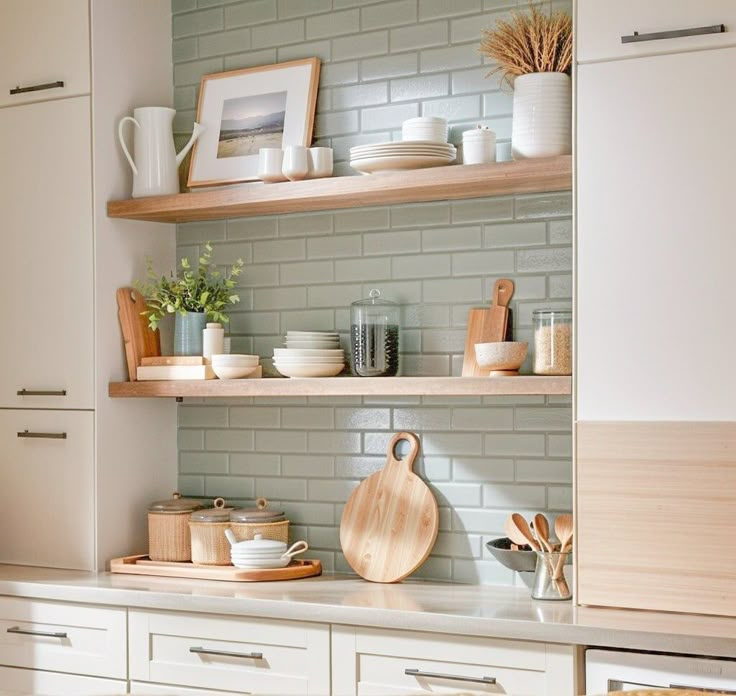
Open shelving creates an inviting and functional display area, and when paired with sage green walls, it exudes warmth and charm. Wooden shelves, whether in natural oak, walnut, or reclaimed wood, bring a rustic, organic touch to the kitchen, contrasting beautifully against the calm and muted sage backdrop.
The open shelving design encourages creativity in showcasing everyday items. Arrange copper pots, white ceramic dishes, or glass jars filled with pantry staples for both practicality and style. Adding potted plants or trailing greenery enhances the natural aesthetic, tying in seamlessly with the earthy sage tones.
Ensure the shelves are sturdy and appropriately spaced to accommodate a mix of decorative and functional pieces. To create balance, avoid overloading the shelves; the goal is to curate an airy, uncluttered look. Wooden brackets or concealed hardware can complement the shelving while maintaining clean lines.
Pairing this setup with a backsplash in white subway tile or neutral patterns offers contrast while keeping the overall look cohesive. If the kitchen includes sage green cabinetry, the open shelves can extend the design upward, making the walls feel taller and the space more expansive.
Lighting plays a crucial role in emphasizing the beauty of this combination. Install sconces or track lighting above the shelves to highlight both the wood grain and the wall’s sage green tone. Warm light works best to enhance the earthy elements and create a cozy atmosphere.
This design suits various kitchen styles, from farmhouse to Scandinavian, offering both functionality and visual appeal. By combining the raw texture of wood with the soothing elegance of sage green, you create a welcoming, nature-inspired space that feels timeless yet fresh.
Sage Green Cabinets with Black Soapstone Countertops
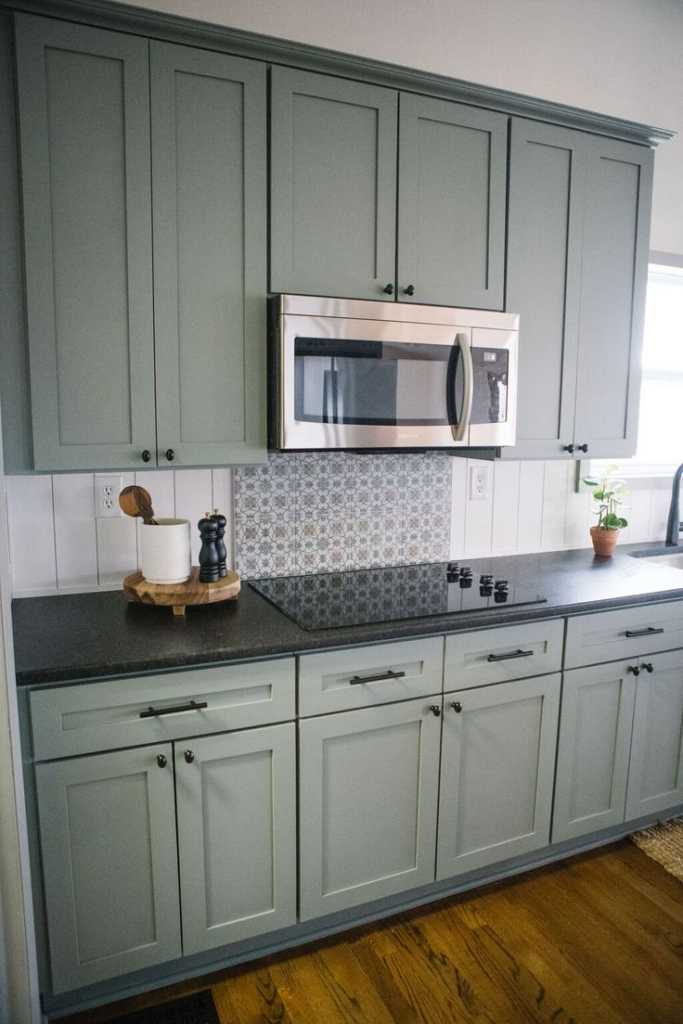
Pairing sage green cabinets with black soapstone countertops creates a sophisticated contrast that blends natural beauty with boldness. The deep, rich tones of soapstone complement the soft elegance of sage green, offering a balanced palette that works in both modern and traditional kitchens.
Soapstone, with its smooth matte finish and subtle veining, adds a luxurious touch without being flashy. It is also highly durable, making it a practical choice for busy kitchens. The combination of sage green cabinets and black countertops provides depth and dimension, especially when paired with warm wooden accents or metallic hardware.
For an industrial or modern look, matte black or brushed gold handles and knobs can tie the cabinetry and countertops together. To brighten the space, consider a white or light gray backsplash in simple tiles, allowing the sage green and soapstone to remain the focal points. Alternatively, choose a sage-toned backsplash to create a seamless, monochromatic look.
Flooring in lighter wood tones or patterned tiles adds a contrasting base that grounds the design. To further enhance the aesthetic, incorporate decor such as green plants, ceramic bowls, or metallic accents that echo the natural and modern tones in the kitchen.
Pendant lighting in black or antique brass over the workspace or island can provide a cohesive finishing touch. For additional functionality, consider under-cabinet lighting to illuminate the soapstone’s veining and highlight the richness of the sage green tones.
This pairing exudes understated luxury, perfect for homeowners who appreciate a bold yet balanced design. Its versatility ensures it complements both contemporary and vintage-inspired kitchens, delivering a look that is both timeless and practical.
Sage Green Pantry Doors with Frosted Glass Inserts
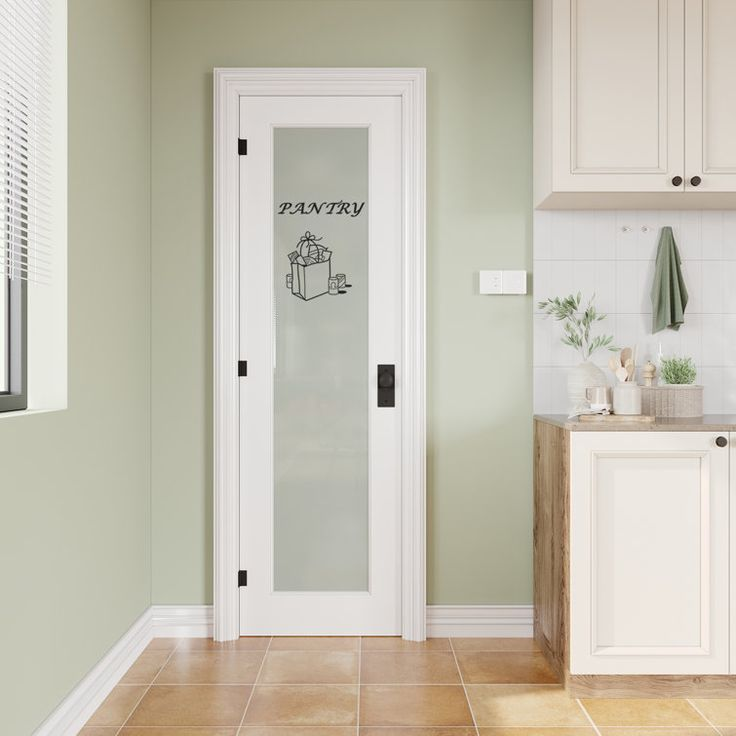
Pantry doors with frosted glass inserts framed by sage green exteriors offer an elegant way to combine functionality with style. The frosted glass adds a layer of sophistication, providing a semi-transparent view of the pantry contents while maintaining a clean and organized appearance. The sage green tone softens the overall look, making it ideal for kitchens that lean toward a cozy, natural aesthetic.
To enhance this design, consider pairing the frosted glass inserts with simple geometric patterns or etchings to add a subtle decorative element. The sage green doors can feature shaker-style panels or clean, modern lines, depending on the kitchen’s overall style. Brushed brass or matte black handles complement the sage tones, adding a finishing touch that elevates the look.
This combination works beautifully with light or medium-toned wood flooring, creating a warm and inviting atmosphere. For the surrounding cabinetry, consider neutral colors like cream or white to ensure the pantry doors stand out as a focal point. Installing soft-close hinges or sliding mechanisms can add functionality and refinement to the design.
Inside the pantry, organized shelving and labeled containers in muted tones keep the look cohesive when the frosted glass offers glimpses inside. Consider LED strip lighting within the pantry to illuminate the space and highlight the frosted glass’s subtle glow.
This design is perfect for modern farmhouse, cottagecore, or even transitional kitchens, offering a timeless feature that feels elegant and practical. Beyond aesthetics, it ensures a functional yet stylish approach to storage that blends seamlessly with the kitchen’s overall design.
Gold Accents on Sage Green Range Hood
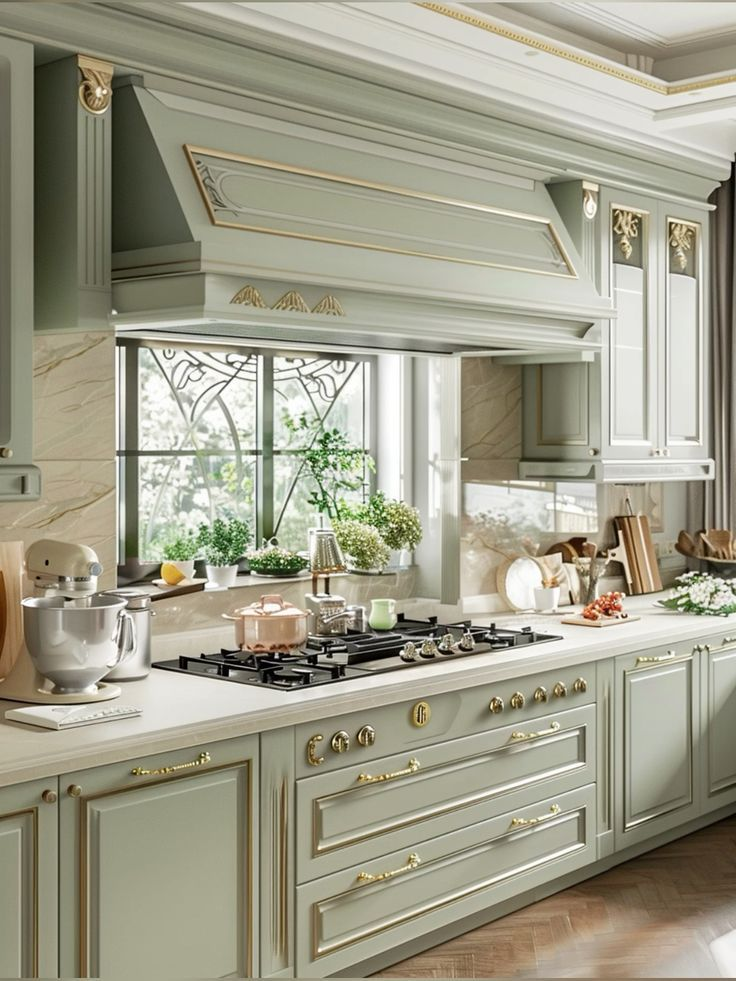
A range hood featuring sage green paired with gold accents creates a focal point that is both luxurious and understated. The green base acts as a grounding color, while the gold details add an opulent touch, perfect for kitchens seeking a balance between rustic charm and modern elegance.
To achieve this look, gold trim or edging along the range hood’s silhouette provides a refined touch. For a more contemporary design, incorporate brushed gold inlays or panels to highlight the hood’s architectural structure. Sage green serves as the dominant color, offering a calming presence that harmonizes with other elements in the kitchen.
Position the range hood against a complementary backsplash, such as white marble with gold veining or simple white subway tiles, to ensure the accents pop. Surrounding cabinetry in matching sage green or neutral tones maintains consistency across the space, while brass or gold hardware on the cabinets ties the look together.
Lighting is key to enhancing the range hood’s details. Install task lighting beneath the hood to illuminate the cooking area and highlight the gold accents. Pendant lights or a statement chandelier with gold finishes can amplify the luxurious vibe, creating a cohesive look throughout the kitchen.
Pairing this feature with warm wood or stone countertops creates a grounded base, balancing the ornate feel of the gold accents. Accessories such as gold-trimmed utensils, metallic vases, or even cookware can further reinforce the design theme.
This combination works exceptionally well in transitional, French country, or contemporary kitchens, offering a timeless appeal that feels both stylish and functional. The sage green and gold pairing ensures the range hood becomes a standout feature that complements the kitchen’s overall aesthetic.
Herringbone Sage Green Tile Backsplash
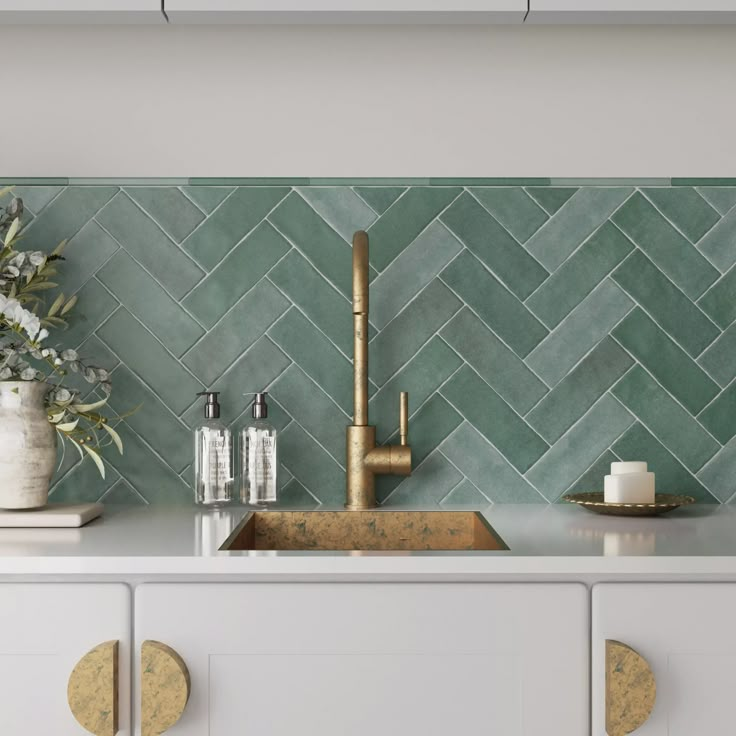
A herringbone backsplash in sage green tiles brings texture and movement to the kitchen, transforming a functional feature into a design statement. The herringbone pattern, known for its dynamic appeal, creates visual interest without overwhelming the space, while the sage green tones evoke calm and serenity.
Choose tiles with a subtle sheen or matte finish to suit the overall kitchen style. Glossy tiles reflect light beautifully, making the space feel larger and brighter, while matte tiles offer a modern, understated elegance. For added depth, opt for tiles with slight tonal variations within the sage green spectrum, creating a rich, layered effect.
Pair this backsplash with light-colored countertops, such as white quartz or marble, to balance the design. Sage green cabinetry can complement the tiles, but if you prefer a more contrasting look, neutral cabinets in white or cream provide a crisp backdrop.
To frame the herringbone pattern, consider a simple border tile in white or gray. This approach highlights the pattern without detracting from the overall design. Under-cabinet lighting enhances the backsplash’s texture, emphasizing the pattern and sage green hue.
Brass or black hardware on the cabinetry ties the look together, while wooden or metallic accents in the kitchen add warmth and depth. For flooring, consider natural wood or patterned tiles to maintain harmony between the backsplash and other elements.
This backsplash style works beautifully in both traditional and modern kitchens, offering timeless appeal with a subtle touch of personality. The herringbone sage green tiles ensure your kitchen stands out while remaining elegant and welcoming.
Farmhouse Sink with Sage Green Cabinetry
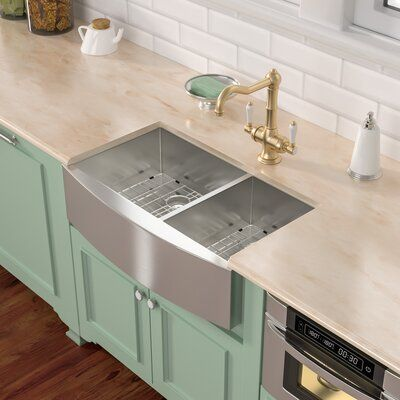
Pairing a farmhouse sink with sage green cabinetry creates a charming, functional focal point that blends rustic and contemporary aesthetics. The deep basin of the farmhouse sink adds practicality, making it perfect for handling large cookware or meal prep, while the surrounding sage green cabinetry brings a soothing and elegant touch to the space.
For a cohesive design, opt for an apron-front sink in white fireclay or stainless steel. The white sink contrasts beautifully with the muted green tones, while stainless steel offers a modern twist for kitchens leaning toward industrial or transitional styles. Incorporate shaker-style cabinetry to maintain the farmhouse-inspired look, or go for sleek, flat panels to add a contemporary edge.
Countertops in light quartz or butcher block enhance the organic feel, while a backsplash in white subway tiles or patterned neutrals adds texture and visual interest. Adding black or brushed gold hardware to the cabinetry ties the look together, giving the kitchen a polished finish.
To further emphasize the farmhouse vibe, consider open shelving above the sink to display rustic dishware, mason jars, or greenery. For flooring, natural wood or wood-look tiles complement the sage green and add warmth to the overall design.
Lighting is essential in highlighting this pairing. Install sconces or pendant lights above the sink area for a functional yet stylish touch. Choose fixtures in brass, matte black, or antique finishes to maintain cohesion with the kitchen’s hardware and accents.
This combination works beautifully in kitchens that aim to strike a balance between timeless charm and modern sophistication. By integrating a farmhouse sink with sage green cabinetry, you create a design that feels grounded, welcoming, and effortlessly stylish.
Sage Green Ceiling with Neutral Cabinets
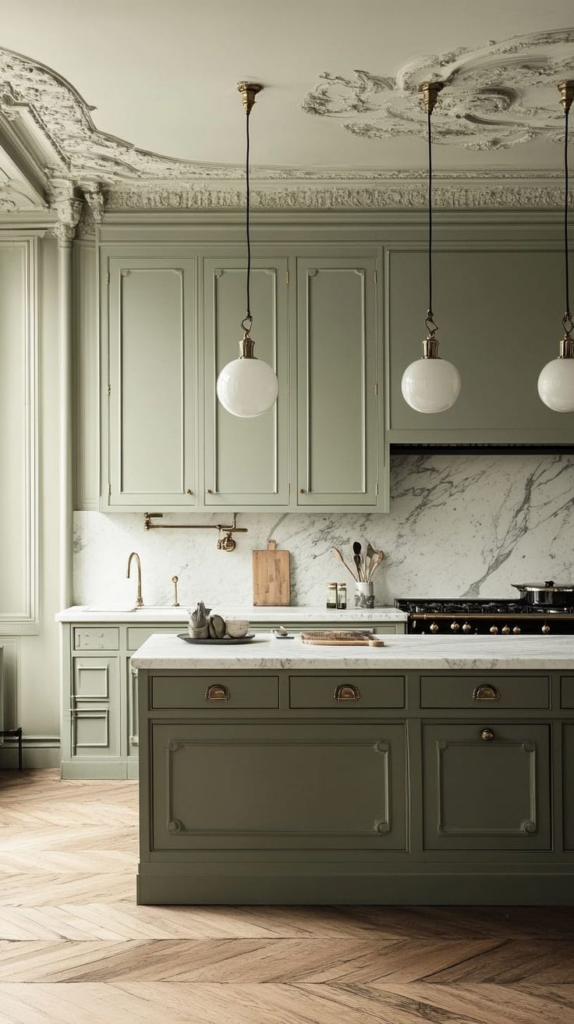
A sage green ceiling paired with neutral cabinets creates an unexpected yet visually stunning feature in the kitchen. This design flips the script by bringing color upward, adding depth and personality to the space without overwhelming it. Neutral cabinets in tones like cream, white, or light gray provide a balanced foundation, ensuring the sage green ceiling stands out as a bold yet tasteful design choice.
To enhance this pairing, consider crown molding in a crisp white or a subtle shade matching the cabinets. This detail frames the ceiling, creating a polished transition between the walls and the ceiling. The sage green overhead draws the eye upward, making the kitchen feel taller and more spacious.
Lighting plays a significant role in this design. Recessed lighting or a statement chandelier ensures the ceiling remains well-lit, emphasizing its unique color. Pendant lights in coordinating finishes, such as brass or matte black, can further enhance the room’s cohesion.
For flooring, medium-toned wood or patterned tiles provide a warm contrast to the cooler tones of the ceiling and cabinetry. A backsplash in white subway tile or natural stone keeps the space feeling light and airy, complementing the neutral cabinets while allowing the sage green ceiling to remain the focal point.
This design works particularly well in kitchens with high ceilings or those that need a pop of personality without overpowering the space. The sage green adds warmth and depth, creating a kitchen environment that feels fresh, inviting, and sophisticated.
Sage Green Beadboard Island with Wooden Countertop

A beadboard island in sage green topped with a wooden countertop combines texture, warmth, and a timeless appeal. The vertical lines of the beadboard add subtle detail and depth, while the sage green tone creates a calming presence. The wooden countertop introduces an organic, rustic element that balances the overall look, making this pairing perfect for farmhouse, coastal, or transitional kitchens.
Choose a natural or stained wood finish for the countertop, such as oak, walnut, or butcher block, to enhance the warmth and contrast with the soft green base. The beadboard detail can extend to the sides of the island for a cohesive look, or you can frame it with trim for added sophistication.
Incorporate storage solutions like pull-out drawers, shelves, or even hidden compartments within the island to maximize its functionality. Bar stools in natural wood or upholstered finishes can be placed on one side of the island, creating a casual dining or seating area.
For surrounding cabinetry, neutral tones like cream, white, or light gray complement the sage green without competing for attention. Hardware in matte black, antique brass, or brushed nickel ties the elements together.
Pair this island design with a light-colored backsplash, such as white subway tiles or soft-patterned ceramics, to maintain balance. Wooden or ceramic pendant lights above the island add to the rustic charm while ensuring proper lighting for the workspace.
The combination of sage green beadboard and a wooden countertop creates a versatile centerpiece that feels both functional and stylish, offering a design that remains timeless and effortlessly elegant.
Sage Green Open Shelving with Copper Pots Display

Open shelving in sage green offers the perfect backdrop for displaying copper pots, blending practicality with a curated aesthetic. This combination brings warmth and a touch of vintage charm to the kitchen, making it ideal for spaces that embrace a rustic, farmhouse, or industrial vibe.
The muted sage green color on the shelves allows the rich tones of copper to shine, creating a striking yet balanced contrast. Install sturdy wooden or MDF shelves with a sage green finish and consider bracket supports in black, brass, or wrought iron for added character. Position the shelves at varying heights to accommodate different sizes of cookware, allowing the display to look dynamic yet organized.
Beyond copper pots, you can layer the shelves with white dishware, glass storage jars, or greenery to soften the look and add variety. To maintain visual harmony, keep other displayed items minimal so the copper remains the star. Add hooks beneath the shelving for hanging ladles or smaller copper pieces, enhancing functionality while maintaining the theme.
Lighting is crucial for highlighting the display. Install focused task lights or under-shelf LED strips to illuminate the pots and create a warm glow that emphasizes their metallic sheen. Complement the shelving with a backsplash in white or cream tiles to keep the overall look light and balanced.
This setup works beautifully with neutral-toned cabinetry or a mix of sage green and natural wood. Copper hardware on surrounding cabinets and fixtures further ties the design together. Wooden or stone countertops add an earthy touch, grounding the kitchen in natural warmth.
By combining sage green open shelving with copper pots, you achieve a design that feels personal and inviting while also providing practical storage. This pairing effortlessly enhances both modern and traditional kitchens, delivering a timeless appeal that’s both functional and visually stunning.
Muted Sage Green Cabinetry with White Shiplap Walls
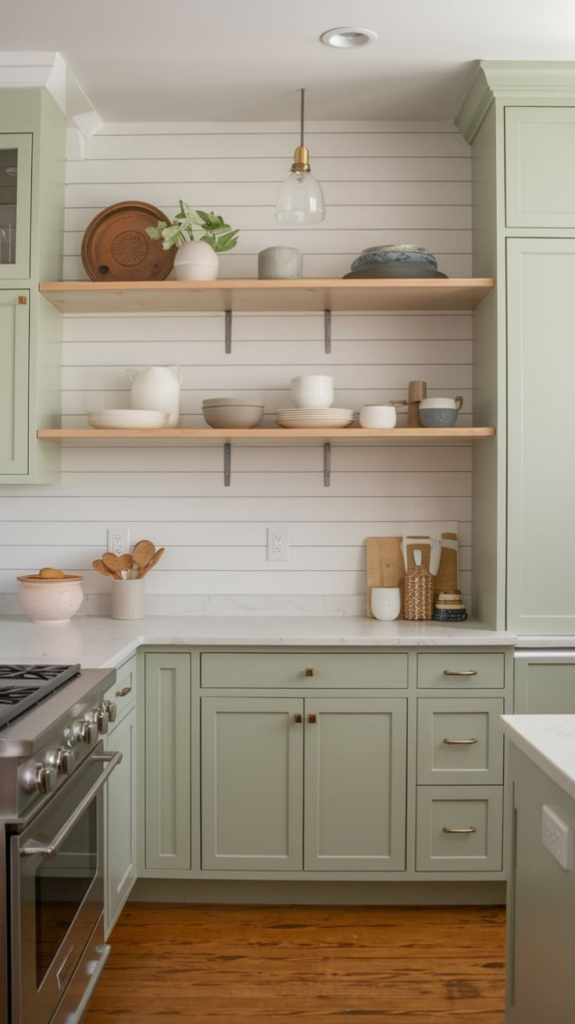
Muted sage green cabinetry paired with white shiplap walls creates a serene and inviting kitchen space that merges rustic charm with modern simplicity. The soft green tones add warmth and depth, while the crisp white shiplap walls provide a textured backdrop, making the room feel both cozy and spacious.
The matte finish of muted sage cabinetry ensures a subtle, understated elegance that works well in various kitchen styles, from coastal to farmhouse. Consider shaker-style doors for the cabinets to maintain a timeless appeal, or go with flat panels for a more contemporary touch. Complement the look with hardware in brushed brass, matte black, or antique pewter, adding a refined detail that enhances the design.
For countertops, opt for white quartz, light marble, or even butcher block to maintain a cohesive color palette. The shiplap walls act as a neutral canvas, allowing the sage green cabinetry to stand out without feeling overwhelming. To add contrast, use a backsplash in soft gray or sage tones, or go bold with patterned tiles for a more eclectic touch.
Flooring options like natural wood or light stone tiles enhance the organic feel of the space, while open shelving or glass-front upper cabinets provide opportunities for display. Arrange neutral or green-toned dishware to complement the palette, and incorporate natural elements like potted herbs or woven baskets for added texture.
Proper lighting is essential to bring out the beauty of this pairing. Pendant lights in warm metals or vintage-inspired fixtures can add character, while under-cabinet lighting ensures functionality. The combination of muted sage green and white shiplap walls creates a design that feels fresh, timeless, and effortlessly sophisticated.
Sage Green and Terra-Cotta Accents
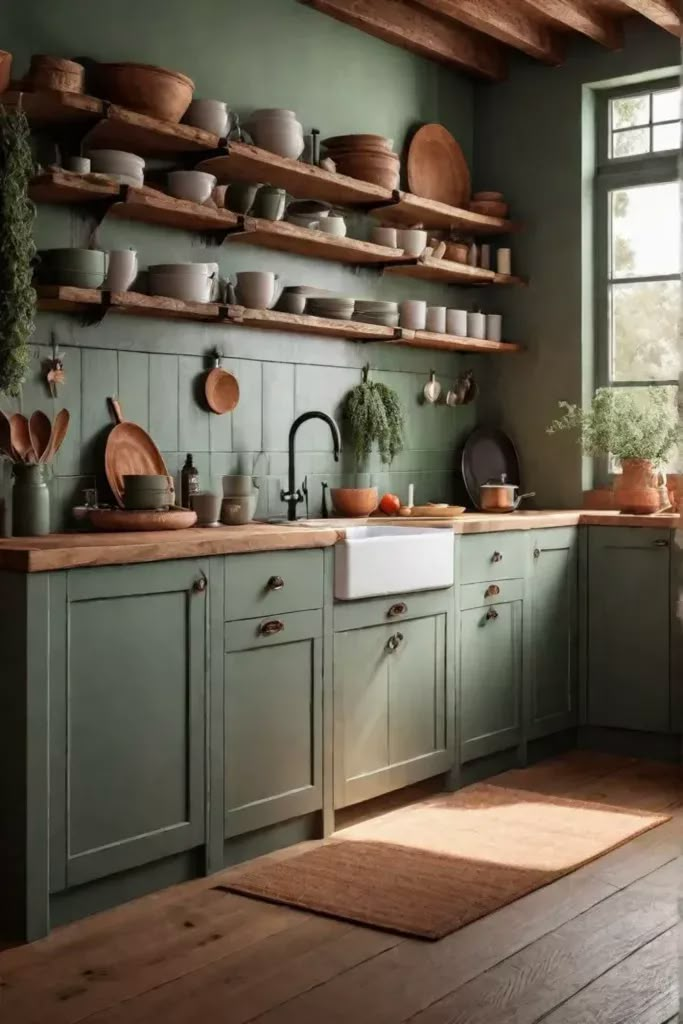
Sage green paired with terra-cotta accents creates a kitchen design steeped in earthy warmth and natural charm. This combination evokes the feel of Mediterranean or bohemian spaces, blending muted green tones with the rich, warm hues of terra-cotta for a balanced yet striking palette.
Consider using terra-cotta tiles for the flooring or backsplash to bring in texture and warmth. For the cabinetry, sage green works as a grounding color that contrasts beautifully with the clay-like tones. This pairing can be further enhanced by introducing wooden countertops or open shelving to create cohesion between the warm and cool tones.
Accessories play a pivotal role in tying the look together. Display terra-cotta planters with herbs or succulents on countertops or open shelves. Add terra-cotta-colored dishware, vases, or even rustic ceramic tiles as accents throughout the kitchen. These elements blend seamlessly with the sage green foundation, adding depth and personality to the space.
To maintain balance, use neutral tones like white or beige for the walls, ensuring the sage green and terra-cotta remain the focal points. Lighting fixtures in bronze or black complement the earthy tones while introducing a touch of industrial or modern flair.
Flooring in terra-cotta tiles or natural stone provides an organic base that enhances the kitchen’s rustic appeal. Sage green cabinetry keeps the design feeling fresh and vibrant, while terra-cotta’s warmth grounds the space, creating a harmonious blend of colors and textures.
This pairing works wonderfully in farmhouse, Mediterranean, or eclectic kitchens, offering a timeless design that feels both welcoming and visually dynamic. The combination ensures the kitchen stands out as a warm, inviting space that’s effortlessly stylish.
